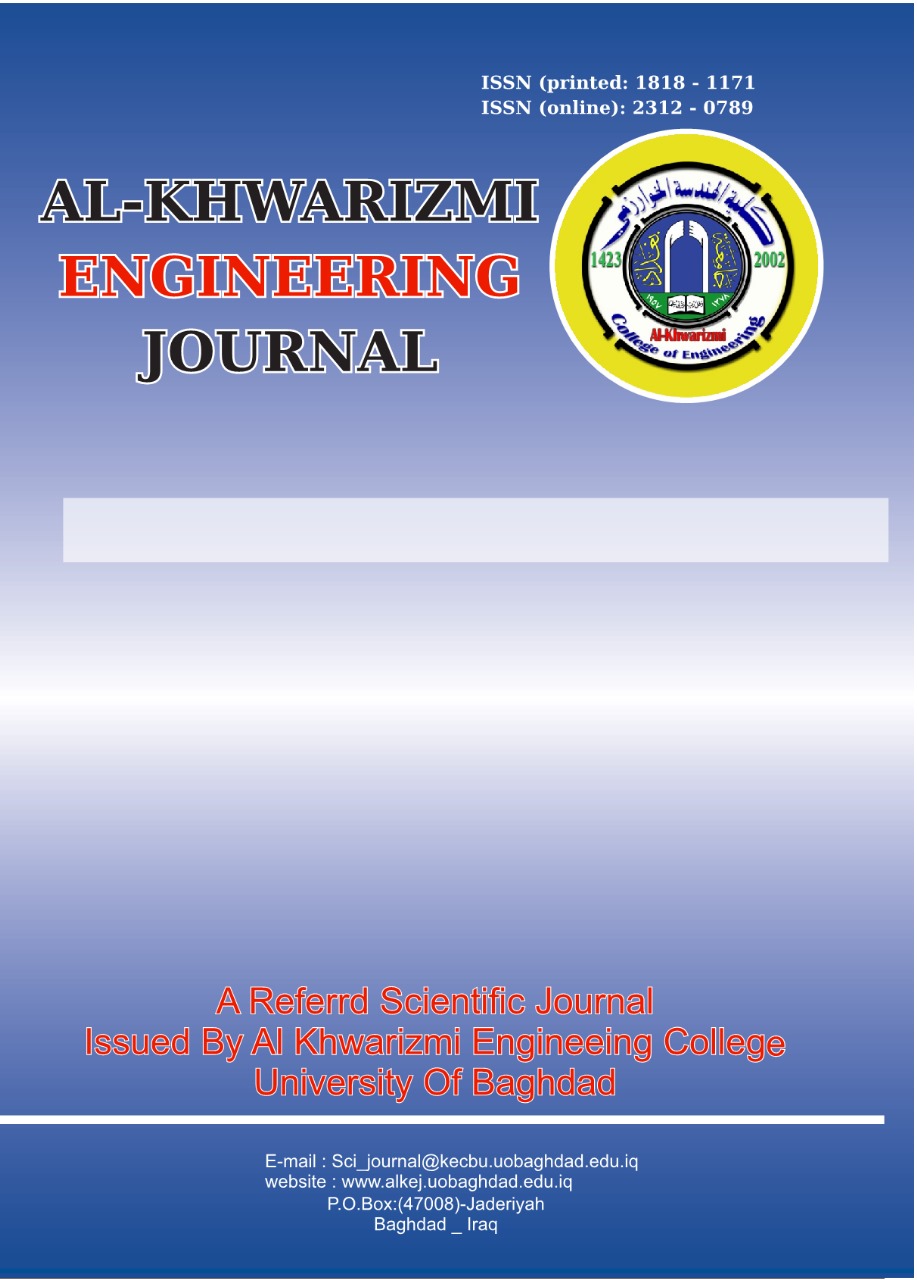تأثير المادة الداعمة على تحطيم صبغة الازو بواسطة عملية (photo-Fenton-like) وباستخدام العمود المتسمر ذو الحشوة الثابتة
DOI:
https://doi.org/10.22153/kej.2022.09.002الملخص
في هذا الدراسة تم استخدام نظام الدفعات المستمرة وعملية (Photo-Fenton-like) لمعالجة مياه الصرف الصحي الملوثة بصبغة زرقاء المعروفة باسم (Direct blue 15). تم استخدام مستخلص أوراق الأوكالبتوس لإنشاء جسيمات نانوية ثنائية المعدن من الحديد / النحاس وتم تحميلها على طين البنتونايت لاستخدامها كمحفزات غير متجانسة. تمت دراسة ومقارنة تكوينين من العمود ذو الحشوة الثابتة. الأول يتضمن خلط البنتونايت الحبيبي مع المحفز واستخدامه كحشوة للعمود، والآخر تضمن خلط المحفز مع الخرز الزجاجية. تم تطبيق طرق التوصيف على الجسيمات النانوية الناتجة، بما في ذلك المسح المجهري الإلكتروني SEM، وإمكانات زيتا (Zeta potential)، وتقنيات التحليل الطيفي للقوى الذرية (AFM). تم دراسة تأثير العوامل الرئيسية على التحلل الصبغة اهمها معدل التدفق، وتركيز الصبغة. تم استخدام منهجية سطح الاستجابة القائمة على التصميم المركب المركزي (CCD) لمعرفة الظروف المثلى لكلا النظامين المدروسين. أظهرت النتائج أن كفاءة الإزالة كانت 81٪ في العمود الذي يحتوي على حبيبات البنتونايت مع المحفز و62.6٪ في العمود الذي يحتوي على الخرز الزجاجية مع المحفز.
التنزيلات
المراجع
Q. Zhao, J. F. Kennedy, X. Wang, X. Yuan, and B. Zhao, “Optimization of ultrasonic circulating extraction of polysaccharides from Asparagus officinalis using response surface methodology,” Int. J. Biol. Macromol., vol. 49, no. 2, pp. 181–187, 2011, doi: 10.1016/j.ijbiomac.2011.04.012.
H. Xiang et al., “Fe3 o4 @c nanoparticles synthesized by in situ solid-phase method for removal of methylene blue,” Nanomaterials, vol. 11, no. 2, pp. 1–20, 2021, doi: 10.3390/nano11020330.
A. Sengupta and A. Sarkar, Chapter 15 - Green synthesis of nanoparticles: prospect for sustainable efficient photocatalytic dye degradation, First Edit. Elsevier Ltd., 2021.
A. M. Tayeb, M. A. Tony, and S. A. Mansour, “Application of Box–Behnken factorial design for parameters optimization of basic dye removal using nano-hematite photo-Fenton tool,” Appl. Water Sci., vol. 8, no. 5, pp. 1–9, 2018, doi: 10.1007/s13201-018-0783-x.
S. Hu, H. Yao, K. Wang, C. Lu, and Y. Wu, “Intensify removal of nitrobenzene from aqueous solution using nano-zero valent iron/granular activated carbon composite as fenton-like catalyst,” Water. Air. Soil Pollut., vol. 226, no. 5, 2015, doi: 10.1007/s11270-015-2421-7.
F. Torrades, J. A. García-Hortal, and L. Núñez, “Fenton and photo-Fenton oxidation of a model mixture of dyes - Overall kinetic analysis,” Color. Technol., vol. 124, no. 6, pp. 370–374, 2008, doi: 10.1111/j.1478-4408.2008.00165.x.
Y. Gou et al., “Degradation of fluoroquinolones in homogeneous and heterogeneous photo-Fenton processes: A review,” Chemosphere, vol. 270, p. 129481, 2021, doi: 10.1016/j.chemosphere.2020.129481.
R. Yamaguchi, S. Kurosu, and M. Suzuki, “Hydroxyl radical generation by zero-valent iron/Cu (ZVI/Cu) bimetallic catalyst in wastewater treatment: Heterogeneous Fenton/Fenton-like reactions by Fenton reagents formed in-situ under oxic conditions,” Chem. Eng. J., vol. 334, pp. 1537–1549, 2018, doi: 10.1016/j.cej.2017.10.154.
K. M. Reza, A. Kurny, and F. Gulshan, “Photocatalytic Degradation of Methylene Blue by Magnetite+H2O2+UV Process,” Int. J. Environ. Sci. Dev., vol. 7, no. 5, pp. 325–329, 2016, doi: 10.7763/ijesd.2016.v7.793.
C. H. Weng, Y. T. Lin, C. K. Chang, and N. Liu, “Decolourization of direct blue 15 by Fenton/ultrasonic process using a zero-valent iron aggregate catalyst,” Ultrason. Sonochem., vol. 20, no. 3, pp. 970–977, 2013, doi: 10.1016/j.ultsonch.2012.09.014.
M. A. Atiya, A. K. Hassan, and F. Q. Kadhim, “Green synthesis of iron nanoparticle using tea leave extract for removal ciprofloxacin (CIP) from aqueous medium,” J. Eng. Sci. Technol., vol. 16, no. 4, pp. 3199–3221, 2021.
I. M. Luaibi, M. A. Atiya, A. K. Hassan, and Z. A. Mahmoud, “Heterogeneous catalytic degradation of dye by Fenton-like oxidation over a continuous system based on Box–Behnken design and traditional batch experiments,” Karbala Int. J. Mod. Sci., vol. 8, no. 2, pp. 9–28, 2022, doi: 10.33640/2405-609x.3217.
T. Bao et al., “Bentonite-supported nano zero-valent iron composite as a green catalyst for bisphenol A degradation: Preparation, performance, and mechanism of action,” J. Environ. Manage., vol. 260, no. January, 2020, doi: 10.1016/j.jenvman.2020.110105.
G. Gopal, H. Sankar, C. Natarajan, and A. Mukherjee, “Tetracycline removal using green synthesized bimetallic nZVI-Cu and bentonite supported green nZVI-Cu nanocomposite: A comparative study,” J. Environ. Manage., vol. 254, no. June 2019, p. 109812, 2020, doi: 10.1016/j.jenvman.2019.109812.
X. Weng, Z. Chen, Z. Chen, M. Megharaj, and R. Naidu, “Clay supported bimetallic Fe/Ni nanoparticles used for reductive degradation of amoxicillin in aqueous solution: Characterization and kinetics,” Colloids Surfaces A Physicochem. Eng. Asp., vol. 443, pp. 404–409, 2014, doi: 10.1016/j.colsurfa.2013.11.047.
E. S. Önal, T. Yatkin, M. Ergüt, and A. Özer, “Green Synthesis of Iron Nanoparticles by Aqueous Extract of Eriobotrya japonica Leaves as a Heterogeneous Fenton-like Catalyst: Degradation of Basic Red 46,” Int. J. Chem. Eng. Appl., vol. 8, no. 5, pp. 327–333, 2017, doi: 10.18178/ijcea.2017.8.5.678.
Z. Wang, C. Fang, and M. Megharaj, “Characterization of iron-polyphenol nanoparticles synthesized by three plant extracts and their fenton oxidation of azo dye,” ACS Sustain. Chem. Eng., vol. 2, no. 4, pp. 1022–1025, 2014, doi:10.1021/sc500021n.
H. M. Abdel-Aziz, R. S. Farag, and S. A. Abdel-Gawad, “Removal of caffeine from aqueous solution by green approach using Ficus Benjamina zero-valent iron/copper nanoparticles,” Adsorpt. Sci. Technol., vol. 38, no. 9–10, pp. 325–343, 2020, doi:10.1177/0263617420947495.
G. Ren et al., “Recent advances of photocatalytic application in water treatment: A review,” Nanomaterials, vol. 11, no. 7, 2021, doi: 10.3390/nano11071804.
T. Mohapatra, V. Kumar, M. Sharma, and P. Ghosh, “Hybrid Fenton Oxidation Processes with Packed Bed or Fluidized Bed Reactor for the Treatment of Organic Pollutants in Wastewater: A Review,” Environ. Eng. Sci., vol. 38, no. 6, pp. 443–457, 2021, doi: 10.1089/ees.2020.0070.
R. Antonelli, G. R. P. Malpass, M. G. C. da Silva, and M. G. A. Vieira, “Fixed-bed adsorption of ciprofloxacin onto bentonite clay: Characterization, mathematical modeling, and DFT-based calculations,” Ind. Eng. Chem. Res., vol. 60, no. 10, pp. 4030–4040, 2021, doi: 10.1021/acs.iecr.0c05700.
M. A. Atiya, A. K. Hassan, and I. M. Luaibi, “Green Synthesis Of Bimetallic Iron / Copper Nanoparticles Using Ficus Leaves Extract For Removing Orange G ( OG ) Dye From Aqueous Medium,” Nat. Environ. Pollut. Technol., 2022.
Y. Süzen and C. Ozmetin, “Removal of reactive black 5 dye using fenton oxidation from aqueous solutions and optimization of response surface methodology,” Desalin. Water Treat., vol. 172, no. October 2018, pp. 106–114, 2019, doi:10.5004/dwt.2019.24943.
M. R. Sabouri, M. R. Sohrabi, and A. Z. Moghaddam, “A Novel and Efficient Dyes Degradation Using Bentonite Supported Zero-Valent Iron-Based Nanocomposites,” ChemistrySelect, vol. 5, no. 1, pp. 369–378, 2020, doi: 10.1002/slct.201904174.
S. C. Azimi, F. Shirini, and A. Pendashteh, “Treatment of wood industry wastewater by combined coagulation–flocculation–decantation and fenton process,” Water Environ. Res., vol. 93, no. 3, pp. 433–444, 2021, doi: 10.1002/wer.1441.
D. Solomon, Z. Kiflie, and S. Van Hulle, “Using Box–Behnken experimental design to optimize the degradation of Basic Blue 41 dye by Fenton reaction,” Int. J. Ind. Chem., vol. 11, no. 1, pp. 43–53, 2020, doi:10.1007/s40090-020-00201-5.
D. Charumathi and N. Das, “Packed bed column studies for the removal of synthetic dyes from textile wastewater using immobilised dead C. tropicalis,” Desalination, vol. 285, pp. 22–30, 2012, doi: 10.1016/j.desal.2011.09.023.
S. S. Madan, B. S. De, and K. L. Wasewar, “Adsorption performance of packed bed column for benzylformic acid removal using CaO2 nanoparticles,” Chem. Data Collect., vol. 23, p. 100267, 2019, doi:10.1016/j.cdc.2019.100267.
V. Parimelazhagan, G. Jeppu, and N. Rampal, “Continuous fixed-bed column studies on congo red dye adsorption-desorption using free and immobilized nelumbo nucifera leaf adsorbent,” Polymers (Basel)., vol. 14, no. 1, 2022, doi: 10.3390/polym14010054.
M. Tamez Uddin, M. Rukanuzzaman, M. Maksudur Rahman Khan, and M. Akhtarul Islam, “Adsorption of methylene blue from aqueous solution by jackfruit (Artocarpus heteropyllus) leaf powder: A fixed-bed column study,” J. Environ. Manage., vol. 90, no. 11, pp. 3443–3450, 2009, doi: 10.1016/j.jenvman.2009.05.030.
K. Sravanthi, D. Ayodhya, and P. Y. Swamy, “Green synthesis, characterization and catalytic activity of 4-nitrophenol reduction and formation of benzimidazoles using bentonite supported zero valent iron nanoparticles,” Mater. Sci. Energy Technol., vol. 2, no. 2, pp. 298–307, 2019, doi: 10.1016/j.mset.2019.02.003.
X. Weng, M. Guo, F. Luo, and Z. Chen, “One-step green synthesis of bimetallic Fe/Ni nanoparticles by eucalyptus leaf extract: Biomolecules identification, characterization and catalytic activity,” Chem. Eng. J., vol. 308, pp. 904–911, 2017, doi: 10.1016/j.cej.2016.09.134.
M. J. Khan, K. Shameli, A. Q. Sazili, J. Selamat, and S. Kumari, “Rapid green synthesis and characterization of silver nanoparticles arbitrated by curcumin in an alkaline medium,” Molecules, vol. 24, no. 4, 2019, doi: 10.3390/molecules24040719.
S. Raja, V. Ramesh, and V. Thivaharan, “Green biosynthesis of silver nanoparticles using Calliandra haematocephala leaf extract, their antibacterial activity and hydrogen peroxide sensing capability,” Arab. J. Chem., vol. 10, no. 2, pp. 253–261, 2017, doi: 10.1016/j.arabjc.2015.06.023.
M. Solís-López, A. Durán-Moreno, F. Rigas, A. A. Morales, M. Navarrete, and R. M. Ramírez-Zamora, “Assessment of Copper Slag as a Sustainable Fenton-Type Photocatalyst for Water Disinfection,” Water Reclam. Sustain., pp. 199–227, 2014, doi:10.1016/B978-0-12-411645-0.00009-2.
M. H. Marzbali and M. Esmaieli, “Fixed bed adsorption of tetracycline on a mesoporous activated carbon: Experimental study and neuro-fuzzy modeling,” J. Appl. Res. Technol., vol. 15, no. 5, pp. 454–463, 2017, doi: 10.1016/j.jart.2017.05.003.
F. Farzaneh Kondori, K. Badii, M. E. Masoumi, and G. Golkarnarenji, “A novel continuous magnetic nano-Fe3O4/perlite fixed bed reactor for catalytic wet peroxide oxidation of dyes: reactor structure,” Int. J. Environ. Sci. Technol., vol. 15, no. 3, pp. 543–550, 2018, doi: 10.1007/s13762-017-1420-1.
التنزيلات
منشور
إصدار
القسم
الرخصة
الحقوق الفكرية (c) 2022 مجلة الخوارزمي الهندسية

هذا العمل مرخص بموجب Creative Commons Attribution 4.0 International License.
حقوق الطبع والنشر: يحتفظ مؤلفو الوصول المفتوح بحقوق الطبع والنشر لاعمالهم، ويتم توزيع جميع مقالات الوصول المفتوح بموجب شروط ترخيص Creative Commons Attribution License، والتي تسمح بالاستخدام غير المقيد والتوزيع والاستنساخ في أي وسيط، بشرط ذكر العمل الأصلي بشكل صحيح. إن استخدام الأسماء الوصفیة العامة، والأسماء التجاریة، والعلامات التجاریة، وما إلی ذلك في ھذا المنشور، حتی وإن لم یتم تحدیدھ بشکل محدد، لا یعني أن ھذه الأسماء غیر محمیة بموجب القوانین واللوائح ذات الصلة. في حين يعتقد أن المشورة والمعلومات في هذه المجلة صحيحة ودقيقة في تاريخ صحتها، لا يمكن للمؤلفين والمحررين ولا الناشر قبول أي مسؤولية قانونية عن أي أخطاء أو سهو قد يتم. لا يقدم الناشر أي ضمان، صريح أو ضمني، فيما يتعلق بالمواد الواردة في هذه الوثيقة.















